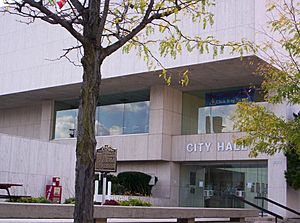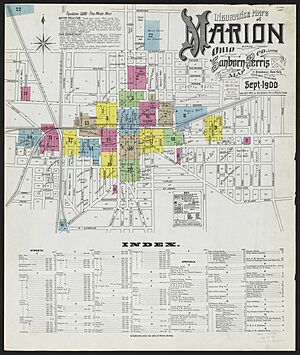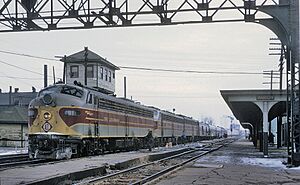Marion, Ohio facts for kids
Quick facts for kids
Marion, Ohio
|
||
|---|---|---|
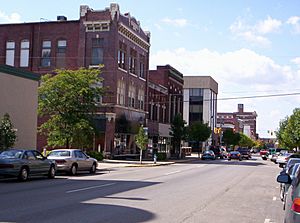
West Center Street in downtown Marion in 2007.
|
||
|
||
| Nicknames:
City of Kings, Popcorn Capital of the World
|
||
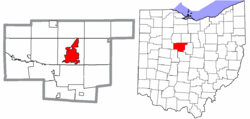
Location of Marion in Marion County and the state of Ohio
|
||
| Country | United States | |
| State | Ohio | |
| County | Marion | |
| Township | Marion | |
| Founded | 1822 | |
| Area | ||
| • Total | 13.05 sq mi (33.81 km2) | |
| • Land | 12.96 sq mi (33.58 km2) | |
| • Water | 0.09 sq mi (0.23 km2) 0.68% | |
| Elevation | 988 ft (301 m) | |
| Population
(2020)
|
||
| • Total | 35,999 | |
| • Density | 2,776.84/sq mi (1,072.16/km2) | |
| Demonym(s) | Marionaire | |
| Time zone | UTC-5 (EST) | |
| • Summer (DST) | UTC-4 (EDT) | |
| ZIP codes |
43301, 43302, 43306, 43307
|
|
| Area code(s) | 740, 220 | |
| FIPS code | 39-47754 | |
| GNIS feature ID | 2395008 | |
| Website | https://www.marionohio.us/ | |
Marion is a city in Ohio, United States. It is the main city and county seat of Marion County, Ohio. You can find it in north-central Ohio, about 50 miles (80 km) north of Columbus.
In 2020, about 35,999 people lived in Marion. It's the biggest city in Marion County.
A famous person from Marion was Warren G. Harding, who became the 29th President of the United States. He used to own the local newspaper, Marion Star. His home and burial place, the Harding Tomb, are in Marion. The city also grew a lot thanks to industrialist Edward Huber and his businesses.
Today, Marion is known as "America's Workforce Development Capital." This means it has many great partnerships between schools and businesses. They work together to offer college programs, job training, and skill certifications. The current mayor of Marion is Scott Schertzer.
Contents
History of Marion
Marion was first planned out in 1822. It was named after General Francis Marion, a hero from the American Revolutionary War. In 1830, Marion officially became a village, and Nathan Peters was elected as its first mayor.
Until the 1970s, Marion was a major industrial hub in Ohio. The Marion Power Shovel company made huge machines. These machines helped build famous projects like the Panama Canal, the Hoover Dam, and the Holland Tunnel. In 1911, an amazing 80% of all steam shovels and heavy earth-moving equipment in the U.S. were made right here in Marion!
Even NASA used Marion's expertise! The company built the giant crawler-transporters. These vehicles moved the massive Saturn V rockets for the Project Apollo missions to the launch pad.
Today, Marion is still important for transportation. It's a rail center for companies like CSX and Norfolk Southern. It's also known for snacks, especially popcorn, because it's close to corn-growing areas. Wyandot Snacks has been here since the 1960s.
The biggest employer in Marion is Whirlpool Corporation. They have the largest clothes dryer factory in the world here! Nucor Steel in Marion is Ohio's biggest maker of rebar (steel bars used in concrete) and signposts.
Marion's Journey Towards Equality
Marion has a history of working towards fairness for all its residents. In the 1800s, it was a stop on the Underground Railroad. This secret network helped enslaved people find freedom.
Over time, the city has faced challenges related to race. In 1919, some African American residents left town due to tensions. However, President Harding, despite some criticism, hired African Americans at his newspaper, The Marion Star. In the 1920s, Marion supported Native American athlete Jim Thorpe. He even helped create an all-Native American NFL team called the Oorang Indians that played in the area.
Today, about 14% of Marion's population are people of color. In 2020, the Marion City Council and Mayor Scott Schertzer made a promise. They passed a resolution to promote fairness and justice for the African American community.
Geography and Climate
Marion is located in a flat area of Ohio called the Till plain. This land was formed thousands of years ago by melting glaciers. The glaciers left behind rich soil, which is great for farming.
The city is about 50 miles (80 km) north of Ohio's capital, Columbus. You can get there by following U.S. Route 23.
Marion covers most of Marion Township. The city's total area is about 11.82 square miles (30.61 km²). Most of this is land, with a small amount of water.
Weather in Marion
| Climate data for Marion, Ohio (1991–2020 normals, extremes 1936-2017) | |||||||||||||
|---|---|---|---|---|---|---|---|---|---|---|---|---|---|
| Month | Jan | Feb | Mar | Apr | May | Jun | Jul | Aug | Sep | Oct | Nov | Dec | Year |
| Record high °F (°C) | 67 (19) |
73 (23) |
84 (29) |
89 (32) |
96 (36) |
103 (39) |
105 (41) |
102 (39) |
100 (38) |
91 (33) |
80 (27) |
73 (23) |
105 (41) |
| Mean maximum °F (°C) | 56 (13) |
60 (16) |
71 (22) |
81 (27) |
87 (31) |
92 (33) |
92 (33) |
91 (33) |
88 (31) |
81 (27) |
69 (21) |
60 (16) |
94 (34) |
| Mean daily maximum °F (°C) | 34.0 (1.1) |
37.1 (2.8) |
47.5 (8.6) |
60.9 (16.1) |
71.7 (22.1) |
80.3 (26.8) |
83.7 (28.7) |
82.0 (27.8) |
76.2 (24.6) |
64.1 (17.8) |
50.3 (10.2) |
38.8 (3.8) |
60.5 (15.8) |
| Daily mean °F (°C) | 25.9 (−3.4) |
28.6 (−1.9) |
37.6 (3.1) |
49.5 (9.7) |
60.6 (15.9) |
69.9 (21.1) |
73.1 (22.8) |
71.3 (21.8) |
64.5 (18.1) |
53.1 (11.7) |
41.3 (5.2) |
31.4 (−0.3) |
50.6 (10.3) |
| Mean daily minimum °F (°C) | 17.9 (−7.8) |
20.1 (−6.6) |
27.7 (−2.4) |
38.2 (3.4) |
49.6 (9.8) |
59.6 (15.3) |
62.6 (17.0) |
60.5 (15.8) |
52.9 (11.6) |
42.1 (5.6) |
32.4 (0.2) |
24.0 (−4.4) |
40.6 (4.8) |
| Mean minimum °F (°C) | −3 (−19) |
2 (−17) |
11 (−12) |
24 (−4) |
35 (2) |
45 (7) |
52 (11) |
50 (10) |
40 (4) |
29 (−2) |
18 (−8) |
7 (−14) |
−5 (−21) |
| Record low °F (°C) | −23 (−31) |
−23 (−31) |
−11 (−24) |
6 (−14) |
21 (−6) |
36 (2) |
41 (5) |
35 (2) |
24 (−4) |
14 (−10) |
−5 (−21) |
−21 (−29) |
−23 (−31) |
| Average precipitation inches (mm) | 2.73 (69) |
1.96 (50) |
2.71 (69) |
3.83 (97) |
4.20 (107) |
4.39 (112) |
4.26 (108) |
3.30 (84) |
3.33 (85) |
3.00 (76) |
3.01 (76) |
2.71 (69) |
39.43 (1,002) |
| Average snowfall inches (cm) | 7.6 (19) |
6.6 (17) |
4.1 (10) |
0.4 (1.0) |
0 (0) |
0 (0) |
0 (0) |
0 (0) |
0 (0) |
0 (0) |
0.6 (1.5) |
4.5 (11) |
23.8 (60) |
| Average extreme snow depth inches (cm) | 5 (13) |
5 (13) |
3 (7.6) |
0 (0) |
0 (0) |
0 (0) |
0 (0) |
0 (0) |
0 (0) |
0 (0) |
0 (0) |
3 (7.6) |
8 (20) |
| Average precipitation days (≥ 0.01 in) | 12 | 9 | 11 | 13 | 13 | 12 | 11 | 10 | 10 | 10 | 10 | 11 | 132 |
| Average snowy days (≥ 0.1 in) | 6 | 5 | 2 | 1 | 0 | 0 | 0 | 0 | 0 | 0 | 1 | 3 | 21 |
| Source: NOAA | |||||||||||||
People of Marion
| Historical population | |||
|---|---|---|---|
| Census | Pop. | %± | |
| 1830 | 287 | — | |
| 1840 | 570 | 98.6% | |
| 1850 | 1,311 | 130.0% | |
| 1860 | 1,844 | 40.7% | |
| 1870 | 2,531 | 37.3% | |
| 1880 | 3,899 | 54.0% | |
| 1890 | 8,327 | 113.6% | |
| 1900 | 11,862 | 42.5% | |
| 1910 | 18,232 | 53.7% | |
| 1920 | 27,891 | 53.0% | |
| 1930 | 31,084 | 11.4% | |
| 1940 | 30,817 | −0.9% | |
| 1950 | 33,817 | 9.7% | |
| 1960 | 37,079 | 9.6% | |
| 1970 | 38,646 | 4.2% | |
| 1980 | 37,040 | −4.2% | |
| 1990 | 34,075 | −8.0% | |
| 2000 | 35,318 | 3.6% | |
| 2010 | 36,837 | 4.3% | |
| 2020 | 35,999 | −2.3% | |
| 2021 (est.) | 35,868 | −2.6% | |
| Population 1830-2000. Population 2010. |
|||
In 2020, Marion had a population of 35,999 people. This was a small decrease from 36,837 people in 2010.
Based on a 2022 survey, there were about 35,927 people living in Marion. Most residents were White (81.7%), and 9.2% were Black or African American. About 4.5% of the population identified as Hispanic or Latino.
The average age in Marion was about 37.7 years old. About 20.5% of the people were under 18 years old.
Economy and Jobs
Marion is in a mostly rural area, but manufacturing provides many jobs. The city is a great place for moving goods by train and truck. It has easy access to major highways like U.S. 23, which connects to Interstate 80 and Interstate 90.
One of the largest facilities for moving goods between trains and trucks in the country is in Marion. It helps companies like Whirlpool Corporation and International Paper deliver their products.
Whirlpool's dryer factory in Marion is the biggest in the world. It makes over 20,000 dryers every single day!
Top Employers in Marion
Here are some of the largest industrial employers in Marion:
| # | Employer | # of Employees |
|---|---|---|
| 1 | Whirlpool Corporation | 2,900 |
| 2 | Silverline Windows | 670 |
| 3 | Wyandot Snacks | 336 |
| 4 | Piston Group | 302 |
| 5 | Nucor Steel | 263 |
| 6 | Graphic Packaging | 250 |
| 6 | Union Tank Car Company | 250 |
| 8 | US Yachiyo, Inc. | 240 |
| 9 | General Mills | 200 |
| 10 | TODCO | 140 |
| 11 | ArcelorMittal | 104 |
| 12 | Sims Brothers | 103 |
| 13 | International Paper | 101 |
| 13 | Sika Corp. | 101 |
New Developments
Marion's economy has been growing since the Great Recession. Ohio is a big steel-producing state. Nucor Steel in Marion, which makes rebar and signposts, invested $85 million to update its factory in 2017. Also in 2017, POET announced plans to spend $120 million to more than double its ethanol production.
A campaign called MarionMade! helps share good news about the area. It won an award for promoting positive stories about Marion's people, places, and products.
Arts and Culture
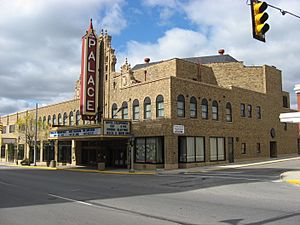
Performing Arts
The Palace Theatre is a beautiful old theater built in 1928. It has 1440 seats and was designed to look like an outdoor palace courtyard, with a blue sky and twinkling stars inside! It's one of only 16 such "atmospheric theatres" still operating in the U.S. The theater hosts touring artists, children's shows, and local plays.
Museums to Explore
- Heritage Hall & the Old Post Office
The Old U.S. Post Office (Marion, Ohio) was built in 1910. Today, it's home to Heritage Hall, a museum that helps preserve the history of Marion County, Ohio.
- Wyandot Popcorn Museum
Inside Heritage Hall, you'll find the amazing Wyandot Popcorn Museum! It's the only museum in the world dedicated to popcorn and popcorn machines. It has the largest collection of restored antique popcorn poppers.
- Warren G. Harding Home
The Harding Home was where Warren G. Harding, the 29th U.S. President, lived. He and his wife, Florence, designed the house in 1890. They even got married there! Harding ran his presidential campaign from the front porch of this house. Over 600,000 people came to hear him speak! There's also a special "press house" where reporters typed their stories.
- Huber Machinery Museum
This museum shows off old steam and gasoline tractors and road-building equipment made by Edward Huber's company. Huber Manufacturing made threshers, steam engines, and early road graders. They even made the first "Maintainer," a tractor-sized road grader, in 1943.
- Marion Union Station and Museum
More than 100 trains pass by Union Station every day! The museum has a cool collection of train items. You can also see the AC Tower, which used to control train switches. During World War II, many soldiers passed through this station on their way to Europe.
Fun Annual Events
Marion hosts the Marion Popcorn Festival every September. It's a big event held downtown after Labor Day. The Marion County Fair happens every year in early July. There's also "Saturday in the Park," a children's festival held in Lincoln Park.
Marion is also home to Buckeye Chuck, Ohio's official groundhog. He predicts when spring will arrive on Groundhog Day (February 2)!
Important Landmarks
Harding Home
The Harding Home was the house of Warren G. Harding, who became the 29th President of the United States. He and his future wife, Florence, designed this Queen Anne style house in 1890. They lived there for 30 years before he became president.
Harding Memorial (Harding Tomb)
The Harding Tomb is the burial place of President Warren G. Harding and First Lady Florence Kling Harding. It's a beautiful Greek temple made of white marble. It was finished in 1927. The open design means the Hardings are buried outside, as they wished.
Hotel Harding (The Harding Centre)
Built in 1924, the Hotel Harding was meant to host visitors who came to Marion after President Harding's time in office. It was close to the main train station. Today, it's no longer a hotel. It has been renovated into apartments, and its lobby has been restored to look like it did originally.
Marion Cemetery's Unique Features
- The Merchant Family Memorial (The Rotating Ball)
Marion Cemetery has a very unusual grave marker for the Merchant family. It's a large granite pedestal with a two-ton granite ball on top. What's special is that this ball moves! It shifts about a quarter to a half-inch every year. Scientists aren't entirely sure why it moves, but it might be due to freezing and thawing, small earthquakes, or air/water trapped underneath. This mystery has even been featured in Ripley's Believe it or Not!
Sports in Marion
Marion has a history with sports. The Oorang Indians, an NFL team made up of Native American players, played their only "home" game here in 1923. Marion has also been home to professional indoor football teams like the Marion Blue Racers and the Marion Mayhem, and even a professional ice hockey team, the Marion Barons.
Many minor league baseball teams played in Marion between 1900 and 1951, including the Marion Senators and Marion Cubs. Future President Warren G. Harding was even a part-owner of the Marion Diggers baseball team!
Marion high schools have also won many state championships in different sports.
Education in Marion
Public Schools
Most students in Marion attend schools in the Marion City School District. This district has six elementary schools, one middle school, and Marion Harding High School. Some parts of the city are also served by nearby school districts like Elgin Local and Pleasant Local.
There's also an online public school called Tri-Rivers Educational Computer Association (TRECA) Digital Academy. It's based in Marion and offers online learning for K-12 students across Ohio.
Private Schools
Marion has one private school, St. Mary's School. It teaches students from kindergarten through 8th grade and is connected to the Roman Catholic Diocese of Columbus.
Job Training and Higher Education
- Tri-Rivers Career Center
The Tri-Rivers Career Center and Center for Adult Education offers special training for high school students and adults. They can learn skills for different careers. Tri-Rivers is also home to RAMTEC, a center focused on robotics and advanced manufacturing technology. This is great for students interested in future jobs with robots!
- Colleges in Marion
Marion has two colleges:
-
- Ohio State University at Marion: This is a regional campus of the famous Ohio State University.
- Marion Technical College: This is a community college that shares a campus with OSU Marion.
Libraries
The main public library in the city is the Marion Public Library. The Marion Campus Library, located at OSU Marion, also has a large collection of books and resources for students and the public.
Media and News
The Marion Star is Marion's local newspaper. It was founded in 1877 and was once owned by Warren Harding. Today, it's owned by Gannett and is published daily.
Marion also has several radio stations, including WMRN-FM (country music) and WMRN (news/talk). WOSB plays NPR news and classical music. There's also a low-power Christian TV station, WOCB-CD, that broadcasts local church services and community events.
Transportation Around Marion
The Marion Municipal Airport is just northeast of the city center. You can find local air charter companies and taxi services here.
U.S. Route 23 runs north and south from Marion, connecting it to cities like Findlay and Columbus. Other Ohio state routes also pass through the city.
In the past, many long-distance passenger trains used to stop at Marion Union Station. The last of these trains left in the early 1970s.
Famous People from Marion
Marion is the hometown and burial place of President Warren G. Harding and First Lady Florence Harding.
Another famous person from Marion is Norman Mattoon Thomas. He ran for President six times as a candidate for the Socialist Party of America and helped start the American Civil Liberties Union (ACLU).
- Elsie Janis: A Broadway star, Hollywood writer, composer, and actress from Marion County. She was known as the "Sweetheart of the American Expeditionary Forces" during World War I.
- Marilyn Meseke: A local tap dance instructor who became Miss America in 1938. She was the first winner when talent became part of the competition.
- Mary Ellen Withrow: From Marion County, she is the only person in U.S. history to have been Treasurer at the local (Marion County), state (Ohio), and federal levels of government!
- Jim Thorpe: The famous Native American athlete spent time in Marion County. He coached and played for the National Football League's Oorang Indians team, which played its "home" games in Marion.
Many other notable people have lived in Marion, including:
- Brian Agler: A successful basketball coach.
- Larry Barnett: A Major League Baseball umpire.
- John Dean: A lawyer and key witness during the Watergate scandal.
- Toby Harrah: A 4-time All-Star baseball player.
- Edward Huber: The industrialist and inventor mentioned earlier.
- Aubrey Huff: A baseball player.
- Huey Lewis: The famous singer and songwriter lived in Marion for a few years as a child.
- O.J. McDuffie: A football player for Penn State and the NFL's Miami Dolphins.
- Gerry Mulligan: A famous jazz saxophonist and composer.
- Aron Ralston: An outdoorsman whose survival story was made into the movie 127 Hours.
- Doug Sharp: An Olympic bobsled medalist.
- Norman Thomas: The socialist who ran for president many times.
Images for kids
See also
 In Spanish: Marion (Ohio) para niños
In Spanish: Marion (Ohio) para niños





